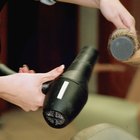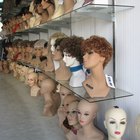
The job of the wig maker was of paramount importance during the colonial times in the United States. Everyone who was anyone wore wigs; the lack of a wig was generally an indication of poverty. As any artisan does, colonial wig makers used their own specific set of tools to produce their works of art.
The Wig Block
Despite sounding like an execution device for wigs, the wig block was, in fact, much more benign than that. It was simply a block of wood in the shape of a head around which the colonial wig makers could shape the wigs.
Wig Points
Wig points were sharp, pointy nails that were used to secure the wig on the wig block while the wig maker was curling and styling it.
Weaving Frame
The weaving frame held silk threads stretched across it. It was used to weave the hair into pieces known as "wafts."
Hackle
The hackle was a tool that looked very much like a comb. The hair was passed through the hackle in order to ready it for weaving.
Comb
The wig maker's comb was just a regular comb that was used to tidy the wig once it was set up on the wig block.
Curling Iron
The curling iron was used to style the wig. In general, men's wigs were worn in simple ponytails during colonial periods, but some women and even some men wanted their wigs styled more elaborately for special occasions.
Dye
The dye was used to change the color of the hair that the wig maker used to make the wigs. In many cases, the hair was gathered from a variety of sources and was not homogeneous in color; thus, dye was necessary.
Related Articles

How Were Colonial Wigs Made?

Black Hairstyles of the 1800s

Who Invented Hair Weaves?

The Tools Used for Curling Hair in the ...

The Short Women's Haircuts of the 1940s

What Is a Capless Wig?

History of Modess Sanitary Napkins

Traditional Roles of Men & Women in ...

The History of Communication Technology

What Is a Rat Hair Piece?

What Is Synthetic Hair Made Of?

How to Apply Full Lace Wigs

Types of Synthetic Hair

Beards of the 70s

History of Body Waxing & Hair Removal

How to Make a Hose Wig Cap

How to Properly Wash a Wig

Chemical Curls for African Americans

Hat Trends of the Seventies

How to Remove Hairspray From Wigs
References
Writer Bio
Hannah Ardeb has been writing and editing since 2008. She has written and ghostwritten content for online platforms including company blogs, marketing blogs and copy for health products and e-commerce websites. Ardeb studies English literature at Bar Ilan University.
Photo Credits
Stockbyte/Stockbyte/Getty Images